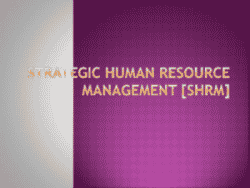Most firms have some sort of human resource management plan in place, even if it is only a simple hiring and onboarding process. Businesses that want to flourish, on the other hand, incorporate strategic human resource management into their processes.
In this post, we’ll define strategic human resource management, look at some examples, look at why it’s important, and talk about how to incorporate the process into your business.
Strategic human resource management (or SHRM) is a comprehensive method to constructing the finest staff for your company’s growth and success.
To truly comprehend strategic human resource management, you must first be conversant with normal human resource management. Human resource management (HRM) is the process and practice of finding, hiring, and training the best people for your business.
HRM also entails providing your employees with the training, development, work environment, perks, and compensation they require to function at their peak among their coworkers and within your organization as a whole.
What is Strategic Human Resource Management?
The link between a company’s human resources and its plans, objectives, and goals is known as strategic human resource management. Strategic human resource management seeks to accomplish the following goals:
- Increase adaptability, innovation, and competitive advantage.
- Create an organizational culture that is purpose-driven.
- Enhance business performance.
Human resources (HR) must play an important role as a strategic partner when corporate policies are defined and executed in order for strategic human resource management to be effective. Strategic HR can be seen in a variety of operations such as hiring, training, and rewarding personnel.
Strategic HR entails investigating how human resources can have a direct impact on a company’s growth. To satisfy the needs of the company’s long-term plans, HR personnel must take a strategic approach to employee development and retention.
HR concerns can be a challenging hurdle for many businesses to overcome; there are numerous components that can confuse business owners and cause them to make unproductive decisions that slow down operations for both their employees and their business.
Strategic Human Resource Management Elements (SHRM)
SHRM’s pillars are as follows:
- Humans are more than simply resources; they are an asset to an organization that should give it a competitive advantage.
- It is the individuals within the organization that are in charge of implementing such transformation.
- Every change is only possible with effective planning and execution in accordance with the organizational demands and objectives.
Strategic Human Resource Management Goals (SHRM)
The primary goal of strategic HRM is to solve issues concerning organizational culture, structure, effectiveness, resource matching, and performance. It entails both the development of process capabilities and the successful management of human capital. The approaches employed in strategic HRM can be divided into five categories:
- Resource-based Strategy:
Addresses issues where the firm’s strategic skills can be enhanced.
- High Commitment Management:
By strengthening the bond between managers and their workforce.
High Involvement Management entails treating employees as business partners.
- High Performance Management:
Improves the firm’s performance by focusing on increasing the productivity, growth, and profitability rate of its employees.
- Achieving Strategic Fit:
Integration of human capital and resources is required for a smooth and profitable business operation.
Human Resource Managers’ Role
Human resource managers who act strategically establish and lead long-term programs that assist an organization’s growth continues. These efforts, if successful, have the potential to drive revenues. Google, for example, is well-known for its innovative employee activities that encourage an innovative culture. Alphabet, its parent firm, was named to Yahoo Finance’s list of the top ten most profitable corporations in the United States in 2020.
While strategic human resource management covers a company’s and its employees’ immediate needs — for example, directing staff hiring, training, and payment processes — it also looks ahead, making plans to meet a company’s overall future needs.
Human Resource Managers’ Responsibilities
Strategic human resource managers oversee a wide range of initiatives aimed at addressing a company’s difficulties and goals. According to the Society for Human Resource Management (SHRM), they base their tactics on four important questions:
- What are we doing now? Strategic human resource managers evaluate the current scenario.
- What do we want to achieve? They think about the outcomes they want.
- How are we going to get there? They devise and implement a process for reaching those objectives.
- How will we know if the process is effective? They establish measures for measuring the effectiveness of those initiatives.
HR managers develop strategies that put employees at the forefront of corporate performance based on the considerations listed above. Human resource managers are responsible for the following tasks:
- Determining personnel and skill requirements
- Employee performance management
- Employee education that reinforces a company’s culture
- Making sure that compensation and benefits are competitive
- Examining competitors’ employee hiring and retention tactics
- Evaluating the outcomes of human resource efforts
What Distinguishes Strategic Human Resource Management from Human Resource Management
Over the previous two decades, there has been a growing realization that HR services were an island unto itself, with softer people-centered principles far removed from the harsh world of real business. To justify its own existence, HR activities needed to be regarded as more intimately interwoven with the enterprise’s strategy and day-to-day operations. Many writers began clamoring in the late 1980s for a more strategic approach to people management than the typical practices of traditional people management or industrial relations models.
Strategic human resource management focuses on long-term human resource programs. Instead of focusing on internal human resource concerns, the emphasis is on identifying and resolving challenges that have a long-term and often worldwide impact on people management initiatives. As a result, the major purpose of strategic human resources is to boost employee productivity by focusing on business challenges that arise outside of human resources.
A strategic human resource manager’s principal actions are to identify critical HR areas where solutions can be adopted in the long run to boost total employee motivation and productivity. Communication between HR and the company’s top management is critical since cooperation is impossible without active engagement.
The Advantages of Human Resource Management Strategic Planning
The more closely HR is aligned with an organization’s entire business strategy, the greater the company’s capacity to anticipate and respond to consumer needs and preserve a competitive advantage. Extensive study, planning, and development incorporating worker culture, habits, and skills promote the successful implementation of business strategy.
The following are some of the specific advantages of strategic human resource management planning:
- Avoiding costly and disruptive surprises that impede goal achievement.
- Addressing critical concerns in a timely manner in order to avoid crises.
- Increasing staff productivity and the overall performance of the organization.
- Providing a sense of direction to favorably influence how work is completed.
- Maintaining staff focus on corporate goals.
- Giving training and development efforts a strategic focus.
- Giving leaders tools to assist them focus on and carry out their strategic ambitions.
Importance of Strategic Human Resource Management
Companies are more likely to succeed when all teams work toward the same goals. Strategic HR analyzes people and identifies the activities that must be taken to maximize their value to the firm. The results of this research are also used by strategic human resource management to build HR approaches to address employee deficiencies.
SHRM Barriers
The barriers to successful SHRM implementation are numerous. The fundamental issue is a lack of or failure to implement a growth strategy. Other key impediments are described below:
- Instilling the transformation effort’s vision and mission.
- High resistance as a result of the bottom line’s unwillingness to cooperate.
- Interdepartmental strife.
- The entire senior management team’s dedication.
- Plans that integrate internal and external resources.
- Time, money, and resources are all limited.
- Employees’ adherence to the status quo.
- Fear of top management’s inability to take strategic initiatives.
- A diverse workforce with competitive skill sets is required.
- In the aftermath of failures, there is a fear of being victimized.
- Inadequate strategic assignments and leadership power struggles
- Power dynamics are affected.
- Legislative changes make you vulnerable.
- Resistance that is channeled through authorized labor institutions.
- The presence of a labor union that is active.
- Rapid structural transformations.
- Economic and commercial factors spurred the adoption of strategic human resource management.
- A more varied, outward-looking strategy is preferred.
4 Examples of Strategic Human Resource Management (SHRM)
#1. Walmart
Walmart is the world’s largest employer, employing over two million people. This retail behemoth places a premium on the importance of human resources in driving and growing its business. The emphasis on employee value was clear from the beginning, when Walmart’s founder, Sam Walton, dubbed the HR department the “people division.”
Walmart is presented as an example by HR Magazine of how strategic human resource management can be used to develop a prosperous organization. The article discusses how Walmart connects its seven overarching strategies (pricing, operations, culture, key item/products, expenses, talent, and service) with human resource strategic management, including:
- Walmart achieves operational success by investing in continual training and learning for its staff. Walmart also strives to enable its employees to take ownership of their job in order to foster more effective teamwork.
- The managers receive cultural training at the Walton Institute, which emphasizes company culture. Managers with an entrepreneurial mindset that supports a problem-solving approach define the Walmart culture.
- Connecting people to items is an area where everyone at Walmart, regardless of position, must focus on how to improve the customer experience. Walmart’s HR approach includes training managers to make judgments on customers in their store as rapidly as possible.
In addition to Walmart, Human Resources MBA developed a list of 30 of the world’s most creative HR departments.
Read Also; Fortune Global 500: 2021 Complete List Ranking & Analysis (Updated)
Other examples of firms that use strategic human resource management to build and strengthen their market position are:
#2. FedEx
FedEx has a ‘People-Service-Profit’ attitude that reflects the company’s view that if people are taken care of, they will take care of customers. As part of fulfilling this tagline, FedEx conducts a yearly survey and feedback program in which employees submit feedback on many parts of the organization. The data are examined, and action is made to enhance employee circumstances when possible.
#3. Nissan
Nissan employs a philosophy known as kaizen to encourage its staff to constantly strive to improve how they work. This strategy begins throughout the recruitment process, and new personnel is urged to keep developing in order to stand out. Other strategic human resource management techniques at Nissan include giving executives the autonomy to hire and expand their teams.
#4. Alliance Boots GmbH
Alliance Boots GmbH was created on the belief that Boots employees are members of a family. Boots promotes a stress-free work atmosphere and helps managers support their workers. Boots places a high priority on vocational education and was one of the first corporations to offer formal certification to its employees.
Steps to Strategic Human Resource Management.
Strategic human resource management is critical for retaining and developing quality employees. Employees are more likely to feel appreciated and desire to stay with a company that prioritizes employee retention and engagement. Before you can execute strategic human resource management, you must first build a strategic HR planning process by following the stages outlined below:
- Learn everything you can about your company’s goals.
- Examine your HR capabilities.
- Examine your current HR capabilities in light of your objectives.
- Estimate your company’s future human resource needs.
- Determine the tools that staff will need to execute the project.
- Put the human resource management strategy into action.
- Assessment and corrective action
#1. Gain a deep understanding of your company’s goals.
Because the effectiveness of strategic HR is determined by how well it connects to the goals of your firm, you must have a solid understanding of your goals, objectives, and mission. You must be able to describe both your short and long-term growth plans to the appropriate HR professionals. Ensuring that your company’s goals are communicated clearly can make it easier for HR personnel to develop an efficient resource management strategy.
#2. Assess your HR capabilities.
Evaluating your present HR capabilities will allow you to better understand your personnel and how they contribute to the achievement of your goals and objectives. In addition, you should do a skills inventory for each employee. Skills inventories assist you in determining which staff are experts in specific areas.
It also assists you in identifying employees who are interested in being taught in a specific component of your firm. A performance review is an excellent time to assess skills. The standard performance evaluation, on the other hand, is on its way out.
#3. Examine your current HR capabilities in light of your objectives.
An assessment of your HR capabilities can assist you in identifying roadblocks and implementing a strategy to capitalize on opportunities and successfully deal with challenges. Strategic HR personnel will examine the number of employees as well as their abilities and will collaborate with senior management to identify strategies to better equip employees to suit your company’s needs.
#4. Estimate your company’s future human resource needs.
After analyzing your company’s workers and talents in connection to your goals, it’s time to forecast your HR needs. The forecast should take into account:
- Demand – A prediction of the number of personnel with the associated abilities that will be required to meet your company’s future needs must be made.
- Supply — Considers the workers and abilities that are now available to assist your organization in meeting its strategic objectives.
Forecasting your company’s future human resource needs determines the following:
- New positions and functions are required to safeguard the company’s future.
- Current employees must have certain skills in order to take on the duties of new positions and functions.
- Whether or not your employees’ expertise is being fully exploited.
- Whether present HR people and practices are capable of accommodating the company’s expansion.
#5. Identify the tools needed by staff to execute the job.
HR officials must work with the appropriate departments to determine how employees’ tools affect their capacity to do their tasks. For example, a hardware and software audit can be conducted in collaboration with the I.T department to discover gaps in tools that will allow for a more organized staff.
For example, if a company uses hourly workers, workforce management software is essential. This program handles critical HR activities like scheduling, holiday entitlement, and sick leave management.
#6. Put the human resource management strategy into action.
After your company’s HR requirements have been analyzed and forecasted, it’s time to begin the process of increasing your staff and developing current employees to prepare your organization for future growth. You may put your human resource management strategy into action by performing the following:
- Begin with the recruitment stage — At this step, HR professionals start looking for people who have the capabilities indicated during the HR strategic planning process.
- Organize a selection process – This is when interviews and other selection criteria take place. Interview questions such as “what are your salary requirements?” and appropriate tests will be used to determine whether the candidate is qualified for the position.
- Begin interviewing candidates – After all necessary checks have been completed, your organization will make the individual a job offer.
- Onboarding and training design – Employee onboarding is a critical component in determining whether an employee stays with a company. To boost employee retention, a comprehensive onboarding and training program must be implemented. After you’ve properly onboarded your staff, another critical step in retaining them is to keep them engaged!
#7. Assessment and corrective action
HR employees should establish a timetable for conducting a strategic HR management review. This evaluation will keep track of progress and highlight areas for improvement. The review should be weighed against whether the modifications are assisting your organization in meeting its objectives. If strategic human resource management fails to accomplish its objectives, corrective action must be implemented.
Process of Strategic Human Resource Management Planning
#1. Be aware of your business’s objectives.
Before you can apply SHRM, you must first establish your business’s objectives.
Whether it’s increasing market penetration, development into new markets, or a better bottom line, setting goals allows you to develop strategies (functional, business, and corporate) to achieve those goals.
Your HR staff may then begin the process of implementing strategic human resource management with this road map in mind.
#2. Assess Your Team
When you’ve determined where you want your business to go (via the goals and strategies you devised in step one), you can assess your current team to see how their talents contribute to the goals you’ve set.
It is also critical to select team members who are eager to learn new parts of your business. Periodic performance assessments are an excellent chance to evaluate all of these aspects.
#3. Examine Your Human Resources Capabilities
If you want your new strategy to succeed, you must first assess your HR capabilities.
Is your HR department equipped and ready to handle strategic human resource management? Do the team members have sufficient knowledge and training?
If not, you may need to make some adjustments inside the department, provide on-the-job training, or hire new people to help with the transition.
#4. Investigate Each Department
Once your HR department is ready, it’s time to let them free on the other departments that make up your business, with the goal of bringing them all into line with your goals and strategies.
The goal of this analysis is to identify each department’s specific demands and how HR can give the talent to boost performance to 100%.
#5. Begin Hiring to Meet Departmental Requirements
With the department’s needs in mind, Human Resources may begin hiring to meet those needs.
Some departments may require specific abilities, but others may require team members that fit more easily into the existing company culture.
Your firm can hire the best personnel to take it to the next level and beyond with strategic human resource management.
Articles About Strategic Human Resource Management
Several articles on strategic human resource management have been created to assist businesses in implementing this process. Two of our favorites are listed below:
- Emerald Insight produced an article on whether strategic human resource management practices influence performance. The report is based on research that revealed that strategic human resource management techniques like as training, development, and pay had the greatest impact on employee performance.
- Another Sage Journals strategic human resource management article investigates the relationship between strategic human resource management and organizational commitment.
Strategic Human Resource Management Services
Strategic human resource management is critical for any business. Before you contemplate implementing strategic human resource management principles, your company does not need to employ a certain number of personnel. In fact, if you have a plan to expand your business, you should consider integrating that expansion into strategic human resource management.
Some businesses outsource this aspect of their operations because they lack an in-house HR business. Strategic human resource services offer a broad range of HR services, including the development of a human resource management plan. Strategic HR services relieve the stress of both operational and strategic management, allowing your business to develop.
You should use time-saving techniques and software to help your company’s future growth.
What is the role of HR analytics in SHRM?
HR analytics refers to the use of data and analytics in decision-making related to HR practices. In SHRM, HR analytics can help organizations measure and understand the impact of their HR strategies on key business outcomes such as productivity, employee engagement, and turnover. This information can then be used to inform and improve HR strategies.
What is the role of culture in SHRM?
Culture refers to the values, beliefs, and behaviors that are shared by an organization’s members. In SHRM, culture is an important consideration as it can impact employee behavior and attitudes, as well as the overall effectiveness of HR strategies. Organizations can use SHRM to shape and support a positive, productive culture that aligns with their business goals.
What are the most common HR challenges faced by organizations and how can they be addressed through SHRM?
Common HR challenges faced by organizations include attracting and retaining talent, managing diversity and inclusion, ensuring compliance with employment laws, and maintaining employee engagement and motivation. SHRM can help organizations address these challenges by developing HR strategies that are aligned with the organization’s goals and objectives, and that support a positive work environment.
How can organizations measure the effectiveness of their SHRM strategies?
Organizations can measure the effectiveness of their SHRM strategies through various methods, such as employee engagement surveys, turnover rates, and HR metrics such as cost per hire and time-to-fill. These metrics can provide valuable insight into the impact of HR strategies on key business outcomes, allowing organizations to continually improve their SHRM practices.
What is the role of HR policies and procedures in SHRM?
HR policies and procedures provide a framework for consistent and effective HR practices. In SHRM, well-designed HR policies and procedures can help organizations attract and retain talent, manage diversity and inclusion, ensure compliance with employment laws, and maintain employee engagement and motivation.
How can organizations continuously improve their SHRM practices?
Organizations can continuously improve their SHRM practices by regularly reviewing and refining their HR strategies, monitoring the effectiveness of their HR policies and procedures, and seeking feedback from employees. Additionally, organizations can stay up-to-date on best practices in HR and incorporate new ideas and approaches into their SHRM practices.
Conclusion
Strategic Human Resource Management is much more than meets the eye. HR should not simply match its practices with the business plan; in order to be genuinely strategic, HR should understand where the strategy comes from and connect with the many stakeholders for whom the strategy is designed.
HR will be able to add enormous value to the organization if it is successful in this endeavor.
I hope this essay has provided you with a decent understanding of Strategic Human Resource Management.
Strategic Human Resource Management FAQs
How does HR management support business strategy?
HR can ensure that talent and people issues are addressed in the corporate strategy. HR frequently has access to important statistics and expertise about existing and prospective talent strengths, weaknesses, opportunities, and threats, and may bring these insights into strategic talks at an early stage.
What are the types of HR strategies?
However, there are two main sorts of HR strategies that can be defined. There are two types of strategies: overarching strategies and specific strategies relating to various components of human resource management.
What is a good HR strategy?
The key to developing a successful HR strategy is identifying what unites and drives people and developing a strategic plan based on that understanding. Consider conducting a regular poll in which you ask employees what inspires them and ask them to rank a series of alternatives in order of importance to them.






